Panel 1
Alessandro Di Menno di Bucchianico, Raffaela Gaddi, con il contributo della rete POLLnet-SNPA e del Centro di monitoraggio aerobiologico dell'Università degli studi di Roma Tor Vergata
The indicator Allergenic and Annual Pollen Integral considers two cumulative metrics: the Annual Pollen Integral (IPAn) and the Allergenic Pollen Integral (IPA), which quantify the total amount of airborne pollen detected over the course of a year in the locations where monitoring stations are installed. Both IPAn and IPA are subject to potentially significant local interannual variability, primarily driven by fluctuations in seasonal meteorological and climatic conditions. These are cumulative quantitative indicators and, as such, do not provide information on the temporal distribution of airborne pollen throughout the year.
The pollen integral represents the sum of the daily average pollen concentrations over a given time interval or, equivalently, the product of the seasonal mean concentration and its duration. This term was traditionally referred to as an index (e.g., annual or seasonal pollen index), but such terminology is now outdated and has been superseded in the scientific literature (Galán et al., 2017).
The Annual Pollen Integral (IPAn) is calculated as the sum of daily concentrations of pollen from a specific botanical family measured during the reference year, whereas the Allergenic Pollen Integral (IPA) corresponds to the sum of pollen concentrations from the main and most widespread allergenic families present across the national territory. The botanical taxa considered include: Asteraceae (also known as Compositae), Betuloideae and Coryloideae (subfamilies within Betulaceae, which historically included taxa formerly assigned to the Betulaceae and Corylaceae families), Cupressaceae and Taxaceae (grouped together), Poaceae (also referred to as Gramineae), Oleaceae, and Urticaceae. The IPAn reflects the cumulative quantity of pollen grains from a specific species, while the IPA accounts for the total amount of allergenic pollen present in a given locality during the year.
To synthetically assess the allergenic pollen load of a specific location, compare it with that of other areas, and analyze its spatial variation. Such evaluations contribute to the assessment of health risks associated with allergic diseases and provide a preliminary basis for verifying mitigation actions potentially implemented by the competent authorities.
Direttiva n. 92/43/CEE: Direttiva del Consiglio relativa alla conservazione degli habitat naturali e seminaturali e della flora e della fauna selvatiche. UNI 11108 – 2004: Qualità dell'aria - Metodo di campionamento e conteggio dei granuli pollinici e delle spore fungine aerodisperse.
UNI CEN/TS 16868 – 2015: Ambient Air – Sampling and analysis of airborne pollen and fungal spores for allergy networks – Hirst-type volumetric method.
UNI EN 16868 – 2019: Ambient Air – Sampling and analysis of airborne pollen and fungal spores for allergy networks – Hirst-type volumetric method.
There is no specific regulation that establishes threshold or target concentration limits for airborne pollen.
Panel 2
Galán, C., Ariatti, A., Bonini, M. et al. (2017), Recommended terminology for aerobiological studies. Aerobiologia 33, 293–295. https://doi.org/10.1007/s10453-017-9496-0
ISPRA - Di Menno di Bucchianico A., Gaddi R., Cattani G., et al. (2021), Stato e trend dei principali pollini allergenici in Italia (2003-2019), Rapporti 338/2021, ISBN:978-88-448-1037-5.
Di Menno di Bucchianico, A., Gaddi, R.,Brighetti, M.A. et al. A. Status and Trend of the Main Allergenic Pollen Grains and Alternaria Spores in the City of Rome (2003–2019), Sustainability 2023, 15, 6150. https://doi.org/10.3390/su15076150.
It is a quantitative indicator describing a phenomenon in which qualitative aspects are also of fundamental importance. The spatial and temporal coverage of the indicator is limited.
Activation of new monitoring stations until at least one is established in each provincial capital.
Data quality assessment
SNPA (National Environmental Protection System)
University of Rome “Tor Vergata”
The data provided by the POLLnet SNPA monitoring network are directly accessible. (https://pollnet.isprambiente.it/)
The monitoring data for the Rome area are supplied by the University of Rome “Tor Vergata” (https://web.uniroma2.it)
Comunale (63/7.904)
2023
Indicator assessment
The Annual Pollen Integral (IPAn) is calculated as the sum of daily pollen concentrations for a given botanical family recorded during the reference year, whereas the Allergenic Pollen Integral (IPA) corresponds to the cumulative sum of pollen concentrations from the main and most widespread allergenic families across the national territory: Asteraceae (or Compositae), Betuloideae, Coryloideae, Cupressaceae/Taxaceae, Poaceae (or Gramineae), Oleaceae, and Urticaceae.
In 2023, a total of 64 monitoring stations were operational, of which 62 belong to the SNPA POLLnet network. For 58 of these 64 stations, time series with sufficient data coverage (DC > 70%) were available for indicator calculation. The territorial distribution spans 19 out of 20 Italian regions. A marked spatial variability was observed (Figures 1 to 8): in 2023, the highest value of the Allergenic Pollen Integral was recorded in the municipality of Castel Di Lama (Province of Ascoli Piceno), reaching 57,065 P·d/m³, while the lowest was observed in Reggio Calabria, with 865 P·d/m³ (Table 1 and Figure 8).
It is not possible to define a trend.
Data
Tabella 1: Integrali pollinici annuali e integrale pollinico allergenico (2023)
Elaborazione ISPRA su dati SNPA e Università Roma "Tor Vergata"
[1] Dati del Centro di monitoraggio aerobiologico e ambientale dell'Università di Roma "Tor Vergata"
[2] Copertura dati insufficiente
[3] In grassetto i dati riportati in mappa. Valore evidenziato soltanto per le serie con almeno il 70% di dati validi
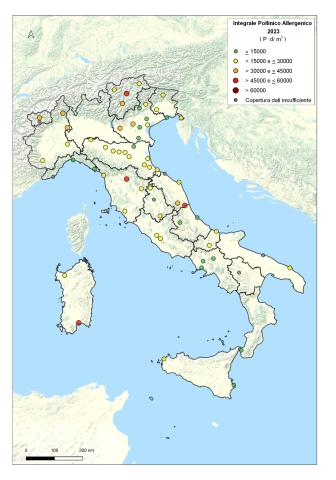
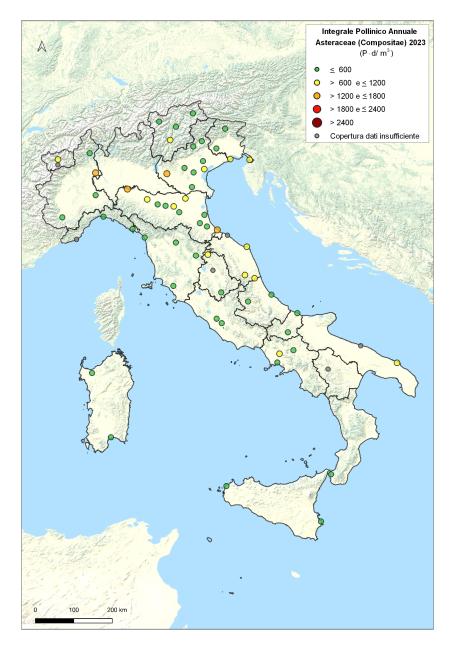
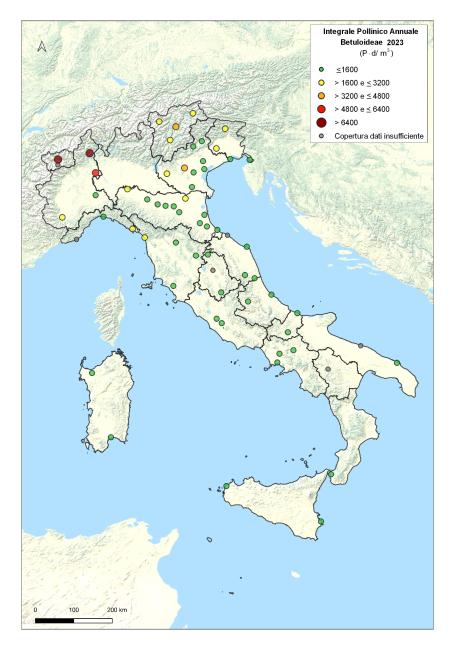
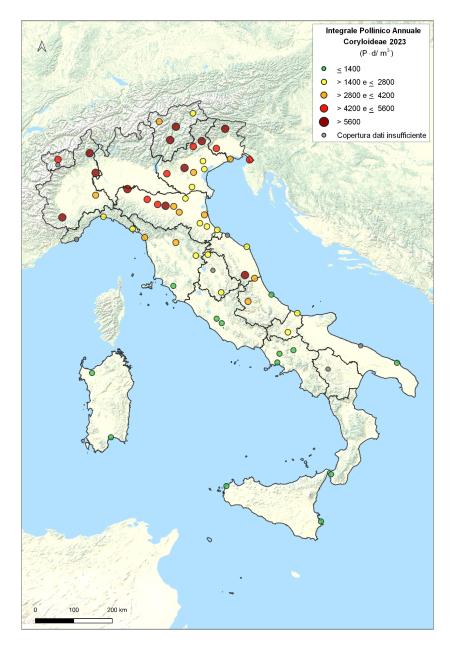
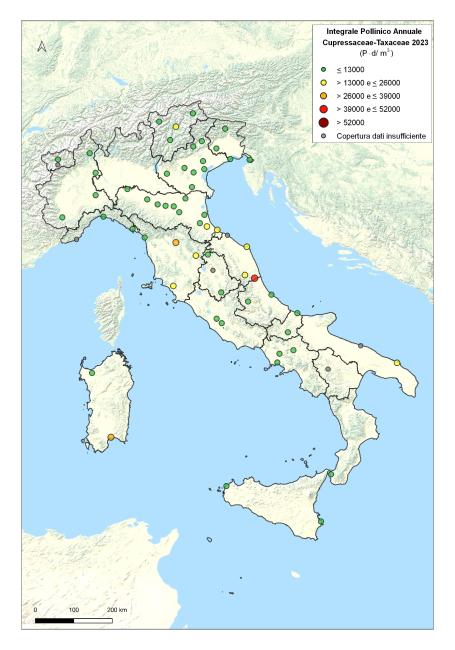
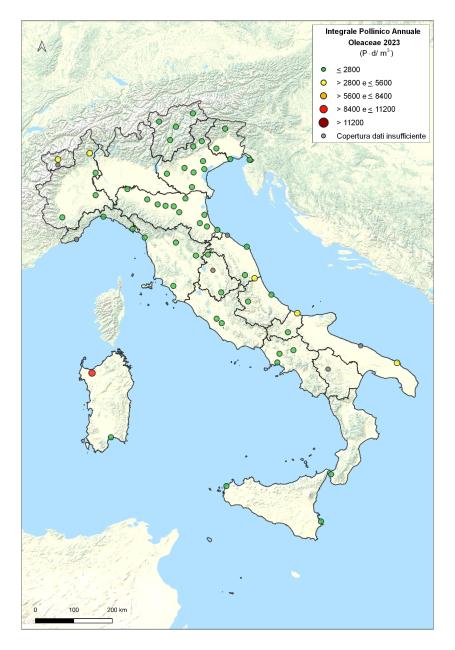
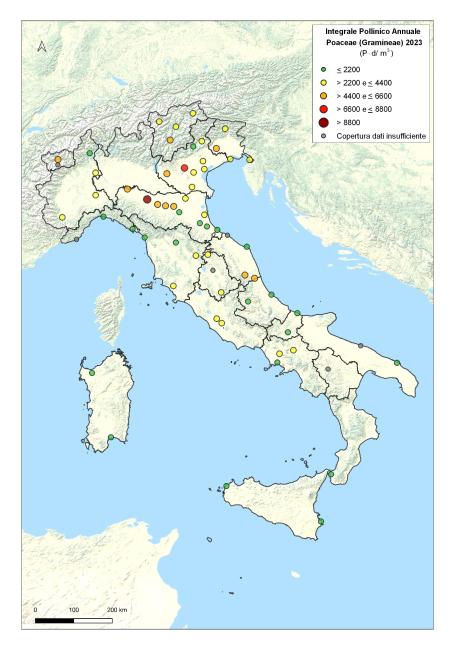
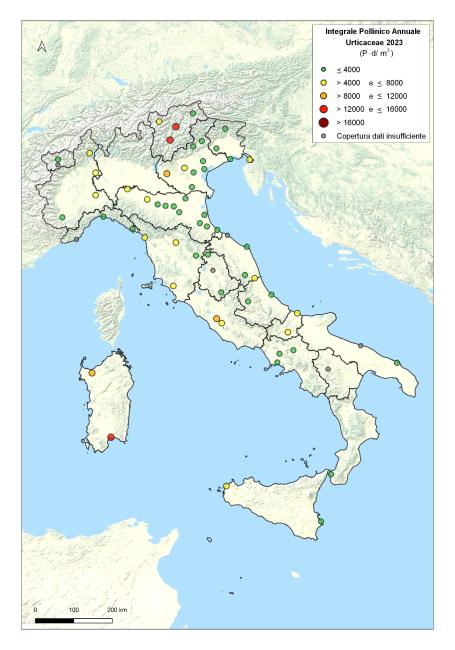
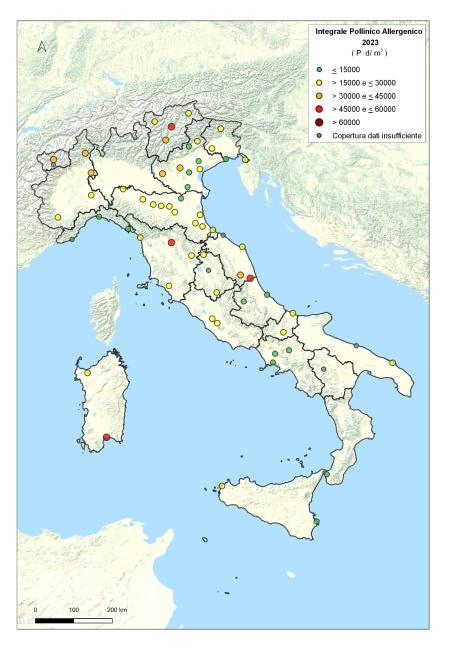
In 2023, the spatial variability of the indicator between monitoring sites was confirmed, along with notable temporal variability at the local scale. Spatial differences are primarily attributable to the positioning of sampling sites, which reflect the general characteristics of local vegetation, and are significantly influenced by microscale factors—namely, proximity to allergenic plant species. Temporal fluctuations, on the other hand, are mainly linked to the meteorological conditions recorded during the year, which can either promote or suppress the presence of airborne pollen.
As reported in Table 1 and Figures 1–7, the highest values recorded by taxon in 2023 were: Asteraceae (Compositae) in Emilia-Romagna, Piacenza (1,537 P·d/m³); Betuloideae in Piedmont, Omegna (14,775 P·d/m³); Coryloideae in Trentino, San Michele all’Adige (13,424 P·d/m³); Cupressaceae–Taxaceae in Marche, Castel di Lama (39,213 P·d/m³); Oleaceae in Sardinia, Sassari (8,853 P·d/m³); Poaceae (Gramineae) in Emilia-Romagna, Parma (8,808 P·d/m³); and Urticaceae in South Tyrol, Bolzano (13,526 P·d/m³). The overall highest Allergenic Pollen Integral values were observed in Castel di Lama (Ascoli Piceno) (57,065 P·d/m³) and in Cagliari (49,575 P·d/m³).
It is worth noting that, particularly in larger urban areas, the atmospheric burden of allergenic pollen is also influenced by the composition and management of urban green spaces. Strategic planning interventions—such as the replacement of allergenic plant species with non-allergenic ones, optimized scheduling of mowing and pruning activities, and proper maintenance of roadsides, sidewalks, and unmanaged areas to prevent the spread of typically allergenic weeds—can significantly reduce airborne allergenic load. These actions, being directly related to air quality and human health, are aligned with Objective 3a of the 7th Environmental Action Programme (7th EAP).